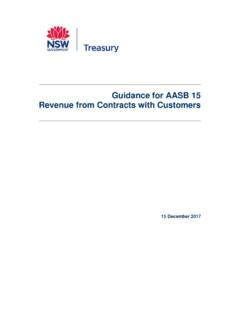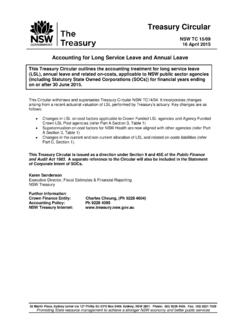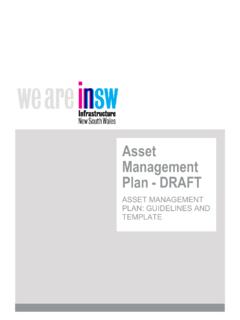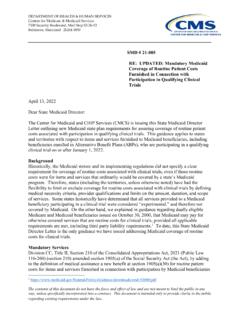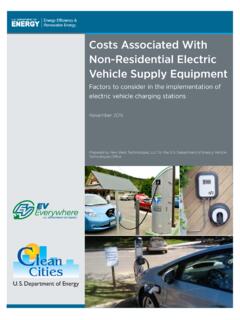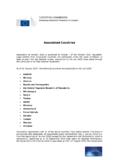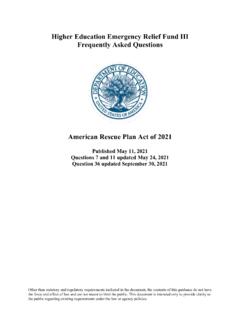Transcription of Capitalisation of costs relating to Cloud-based Software
1 30 September 2020 Capitalisation of costs relating to Cloud-based Software Introduction This guidance relates to the accounting treatment for costs associated with Cloud-based Software . In particular, costs incurred as part of bringing Cloud-based Software into use. It is recommended agencies refer to the full text of AASB 138 Intangibles Assets (AASB 138) and other relevant Accounting Standards, when accounting for Cloud-based Software . 1. What is Cloud-based Software ? Cloud-based Software arrangements generally do not involve customers obtaining Software licences or rights to take possession of Software . Instead, the cloud service provider provides the customer with access to Software , on an as-needed basis. This Software is on the cloud infrastructure of the supplier or a third party, not the customer. The cloud provider is also responsible for maintenance and upgrades of the Software provided. 2. What are the relevant Accounting Standards?
2 Accounting for Cloud-based Software arrangements can be complex and agencies should exercise judgement when determining the appropriate treatment for associated costs . Most assets related to implementing Software as a service (SaaS) arrangements are likely to be intangible assets. Therefore, this guidance focuses on the application of AASB 138 Intangibles Assets (AASB 138) and provides examples of costs that may be capitalised under that Standard. However, arrangements such as platform as a service (PaaS) and infrastructure as a service (IaaS) may involve physical assets, such as routers and firewall. PaaS supplies an on-demand environment that customers can use to develop, test, deliver and manage Software applications. IaaS delivers fundamental compute, network, and storage resources to customers on-demand over the internet. Also, tangible assets may be acquired or enhanced to facilitate Cloud-based computing arrangements.
3 Other relevant Accounting Standards may include: AASB 116 Property, Plant and Equipment (AASB 116): For example, where items of property, plant and equipment (PP&E) are acquired as part of the implementation and ongoing support of a cloud arrangement. AASB 16 Leases (AASB16): For example, when a right-of-use asset arises from a contract where an agency has both the right to obtain substantially all the economic benefits from use of an identified asset, and has the right to direct the use of an identified asset. Note, as discussed later in section , cloud arrangements are generally treated as an operating expense as there is no contractual or legal rights to the specific asset being granted. AASB 136 Impairment of Assets (AASB 136): Requires assets to be assessed annually for impairment. An impairment loss should be recognised where the recoverable amount of an asset is determined to be less than it s carrying value. 3.
4 What are the Capitalisation principles under AASB 138? An intangible asset has the following key characteristics: identifiability, control over a resource, existence of future economic benefits and a lack of physical substance. 30 September 2020 AASB 138, para 8 An asset is a resource: a) controlled by an entity as a result of past events; and b) from which future economic benefits are expected to flow to the entity. An intangible asset is an identifiable non-monetary asset without physical substance. AASB 138, para 12 An asset is identifiable if it either: a) is separable, is capable of being separated or divided from the entity and sold, transferred, licensed, rented or exchanged, either individually or together with a related contract, identifiable asset or liability, regardless of whether the entity intends to do so; or b) arises from contractual or other legal rights, regardless of whether those rights are transferable or separable from the entity or from other rights and obligations.
5 AASB 138, para 13 An entity controls an asset if the entity has the power to obtain the future economic benefits flowing from the underlying resource and to restrict the access of others to those benefits. AASB 138, para 21 An intangible asset shall be recognised if, and only if: a) it is probable that the expected future economic benefits that are attributable to the asset will flow to the entity; and b) the cost of the asset can be measured reliably. AASB 138, para 22 An entity shall assess the probability of expected future benefits using reasonable and supportable assumptions that represent management s best estimate of the economic conditions that will exist over the useful life of the asset. 4. How should costs associated with Cloud-based Software be accounted for in accordance with AASB 138? Capitalising Cloud-based Software The ability to capitalise costs of the cloud Software itself, depends on whether the entity has a Software licence.
6 In other words, whether it controls an identifiable non-monetary asset without physical substance [AASB ]. It is generally considered that an intangible asset exists and the cost of cloud Software can be capitalised, if both of the following criteria are met1: There is a contractual right to take possession of the Software at any time during the hosting period without significant penalty; and It is feasible to either run the Software on the entity s own hardware or contract with another party unrelated to the vendor to host the Software . Typically, cloud Software is purchased under a hosting arrangement and accounted for as a service contract, otherwise known as Software as a Service (SaaS) 2. Where this occurs, ongoing payments 1 Source: Department of Finance Resource Management Guide 109 Accounting for internally developed Software (RMG 109), section 2 Source: IFRIC agenda decision Customer s Right to Receive Access to the Supplier s Software Hosted on the Cloud (IAS 38 Intangible Assets) March 2019.
7 30 September 2020 are treated as operating expenses as there are no contractual or legal rights to the specific asset being granted. costs incurred in bringing the Cloud-based Software into use As discussed in Section , the right to access Software under a cloud arrangement does not typically result in the transfer of the Software license to an agency by the vendor. Therefore, the customer is not acquiring a separate asset under AASB 138 (or AASB 116) that can be capitalised. However, agencies may incur implementation costs in modifying their existing systems to bring the service provider s cloud Software into use. For example, modifying or changing the underlying IT infrastructure to support the Cloud-based Software . Implementation may cover a range of activities, each of which is likely to have a different potential accounting treatment. Typically, implementation includes evaluation of providers, installation and configuration costs , integration with existing systems and middleware, training, data migration and customisation.
8 Where, these costs relate to existing assets that meet the criteria for recognition in AASB 138, the costs incurred during implementation may be capitalised, where agencies obtain future incremental economic benefits from the activities associated with those costs , beyond the period over which the activities are performed [AASB ]. Therefore, it is reasonable to capitalise these implementation costs and amortise them over the term of the cloud arrangement outlined in the service contract, including option periods to extend, where agencies are reasonably certain to exercise. The table below illustrates which costs can typically be capitalised and which should be expensed. Determining which activities in the implementation process are eligible for Capitalisation requires judgement and an analysis of the nature of costs incurred. Implementation activities Accounting treatment Pre-implementation research activities: Preparation of proof of concept, evaluation and selection of a provider.
9 Modifications to current systems: Internal and external costs incurred, to modify provider offerings or develop bridging modules to existing systems or bespoke additional capability. Configuration: set-up current IT environment, systems or network, for specific needs or new capability to enable the use of SaaS. Staff costs : Payroll and other employee related costs for staff who spend time on and are directly associated with the project. This may include testing during Expense, as there is no specific future benefit at this stage. Capitalise, where code or additional capability is developed internally for which the provider does not obtain IP rights, and there are future economic benefits. Capitalise, where material modifications and incremental capability is being added, and there are future economic benefits. Capitalise, as these are directly attributable costs of preparing the asset for its intended use and there are future economic benefits.
10 30 September 2020 Implementation activities Accounting treatment implementation phase, user-acceptance testing, recruitment costs for staff recruited specifically to develop or test the Software , travel costs where these are directly attributable to developing or testing the Software . Data conversion activities: Purging or cleansing of existing data, reconciliation or balancing of the old data and the data in the new system, creation of new or additional data, and conversion of old data to the new system. Data conversion Software : Purchase or development of data conversion Software to perform any of the above tasks identified above. General: Administration and other general overhead costs . Post-implementation activities: costs may include: - Staff training on new Software ; - Development of user manuals; - Post-implementation review; and - Advertising and promotional activities. Expense, where costs incurred relate to staff training during implementation phase.

